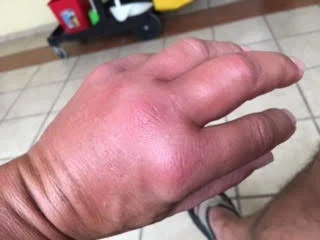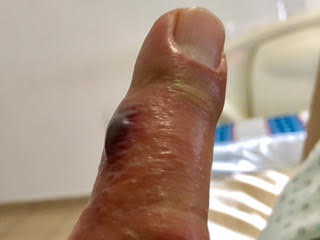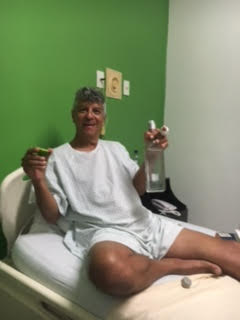Why You Should Never Ignore an Insect Bite in Mexico
Updated September, 2023
Periodically, I hear stories of exotic entomological tales from travelers and residents of Mexico. My friend Michael, a veteran of Mexico after many years of work there and who owns second home in Mazatlán provides a lesson to us all (make sure to hold out for the ending...which illustrates a critical different between Mexican and American hospitals). If you’re only looking most common bug bites and their treatment, see the bottom of the page, but you’ll be missing out.
“We have had a really great time here, Michael writes. “The weather has been perfect, warm sunny days and cool nights. We made some more friends and have done lots of happy hours and listened to much live music. However, I did have somewhat of a misadventure that I will relate to you now that I have your ear (or eyes, I guess).
On Monday I was on our rooftop about to have coffee. I reached down to move a cushion and was stung by a tiny bee. It hurt like a son of a bitch but I removed the stinger and figured it would continue to itch and burn for the day, which it did. I was distracted however by beer, pescado sarandeado, surf and sunshine as we were on a field trip with Pépe to El Caimanero, a distant beach {in other words, an average day in Mexico].
Not good
I went to bed and in the middle of the night I realized that I could barely bend my fingers because of the swelling.
By morning my whole hand had started to swell. It looked like some kind of hoof, no maybe a trotter. I sent the photo below to Lorena and she said she was going to start calling me Pig Man. Rude!
Worse yet, I had developed purple sores on my finger: (see below)
I decided it was time to go to the doctor so I went to the little hospital across the street.
The doctor examined me, removed his glasses and said, "I have bad news for you. This problem is the result of the bee sting, but not the venom. You have a condition called cellulitis.
"That bee had a dirty stinger and when he pierced your skin he infected you with either staph or strep bacteria. The infection has now spread up into your forearm. That purple sore is the beginning of necrosis (skin tissue death)."
"If you had come yesterday I might have been able to treat you with oral medication, but it's too late for that. The infection is traveling in your bloodstream. By this time tomorrow this infection will be in your shoulder and soon after that in your lymph glands.
The necrosis can spread quickly, causing tissue damage that is irreversible. This is very serious. The only option now is immediate hospitalization and intravenous medication."
You can imagine my surprise. But what could I do? I was picturing what I might end up looking like if my skin started rotting. (See right)
So that's how I ended up spending the next 48 hours in a hospital bed attached by tubes to one of those tall racks with plastic sacks hanging from them being pumped full of what seemed like copious quantities of saline, ciproflaxin, and painkillers (though, alas, no opioids).
All's well that ends with a bottle of fine vodka in your hand.
It was boring but not that bad. The nurses were young and really cute (though they refused my requests for a sponge bath). I got lots of sympathy and attention, both of which I thrive on.
My wife brought me coffee in the morning and bowls of fresh watermelon. I had visits from several groups of friends who even organized Happy Hour in my room. (Mexican hospitals are very liberal about visitation).
Lessons learned:
Keep your stinger clean. You never know what kind of disease you might spread. (This goes for bees and mammals as well)
Oh, and don't ignore a bug bite.
Most common type of bug bites in Mexico and how to treat:
Mosquitoes
These do not require medical attention unless you have secondary symptoms such as joint pain, fever, and swelling of glands that could indicate infection by dengue, zika or chikungunya viruses.
Flea bites
These usually come in the form of a group of small bites. You should clean the infected area with soap and water, and perhaps Calamine ointment (pomada calamina).
Bed bug bites
People react in a number of different ways and many have allergic reactions that intensify the pain. Keep the area clean with soap and water. If lumps occur, see a doctor. Do not self-medicate.
Spider bites
Spider bites come in twos. Most are not serious with the exception of the black widow spider and the Violin Spider (araña violinista, also called the Brown Recluse spider). To treat, wash area with soap and water and apply ice. If the area swells and reddens, see a doctor.
Tick bites
Ticks can carry two other diseases; Lyme disease and Crimea-Congo fever. These infections present a wide range of symptoms, joint pain, sensitivity to light, vomiting, confusion, and abdominal pain, even bleeding among them. These bites need to be treated by a doctor within 48 hours.
Ants bites
The most common to cause a problem are red ants. The bites may blister. Avoid breaking the blister to avoid infection. Treat with Cortizone cream (cortizona)
Scorpion bites
The gravity of the bite will depend on your age, the type of scorpion, and the amount of venom introduced. Remove the stinger by scraping the back of a credit card across the stinger. Don’t use tweezers, which may cause it to burst and increase the level of venom in the system. Wash the area with soap and water and apply ice. If symptoms persist see a doctor (medicines for scorpion bites have improved a great deal in recent years.)
Bee stings
Bee Stings are probably the most dangerous in that many people have allergies to bee stings and (as Michael learned), the infections the stinger can carry. Once you have removed the stinger, treat with white vinegar to reduce the swelling and seek a doctor should more serious symptoms occur.'
While not a bug bite, any type of cut should be treated meticulously in coastal areas as the high level of humidity make cuts slow to heal and easily infected, leading to a host of issues you’d never dream possible from a cut.
Related links
Mosquitoes are the more obvious carriers of diseases such as Chikungunya.
Other tips for nasty bug bits in Mexico.
Up Next:
The long-awaited "Sexiest Songs in Spanish" to celebrate the release of my book on renting in Mexico (and prove conclusively that I know nothing about marketing books).
About the author:
Kerry Baker is a partner with Ventanas Mexico and author of "If Only I Had a Place," about how to rent luxuriously in Mexico for less. “The Mexico Solution” is the ultimate guide to successful part-time expat life, the perfect way to test the waters for retirement in Mexico. “The Mexico Solution: Saving your money, sanity, and quality of life through part-time life in Mexico”.
Her most recent book is a cookbook, “The Lazy Expat: Healthy Meals That Translate in Mexico. In Mexico, you must cook if you wish to maintain a healthy diet. This is book you’ll want to pack for the days when you can’t look at another taco (it happens).



